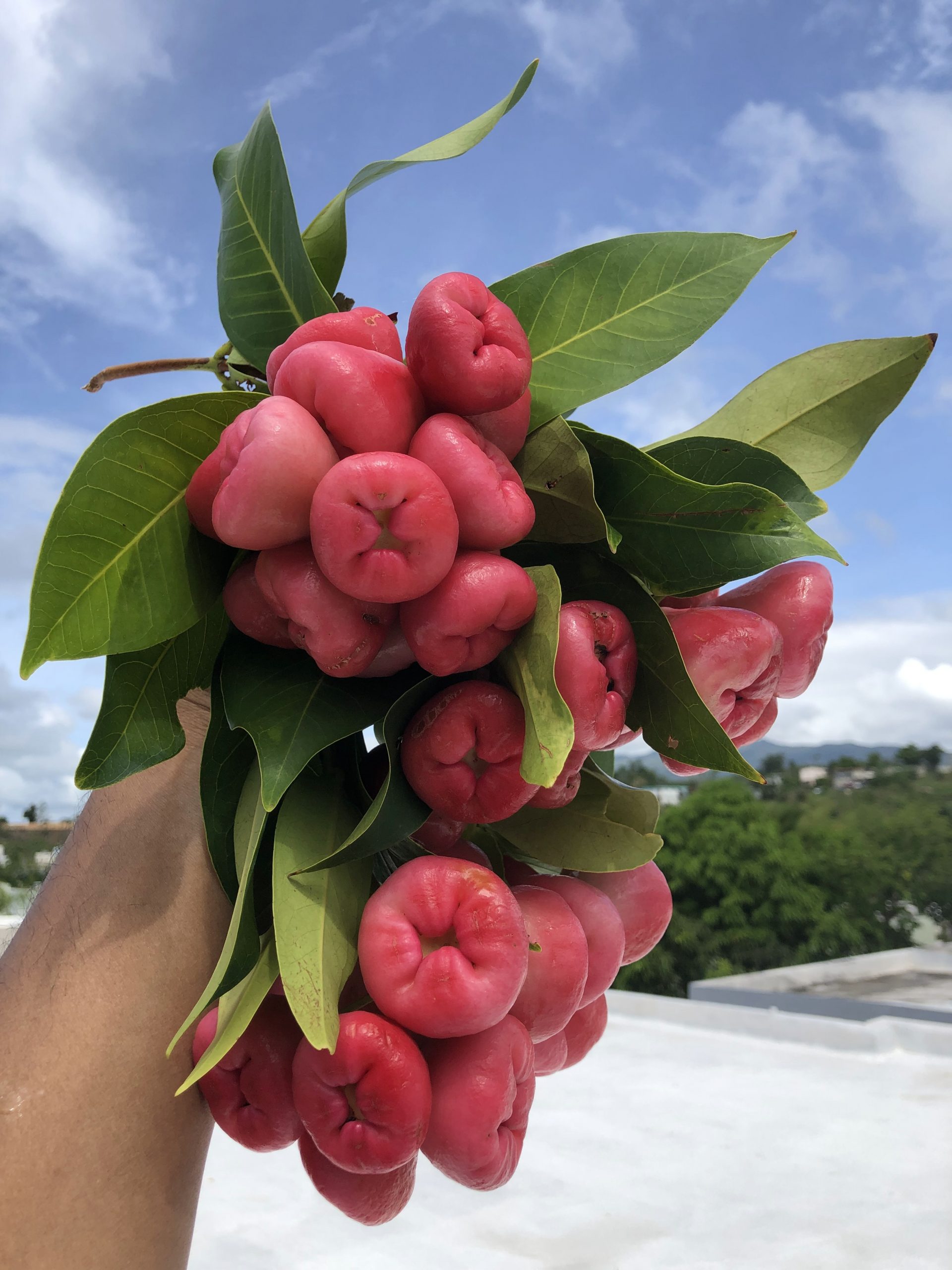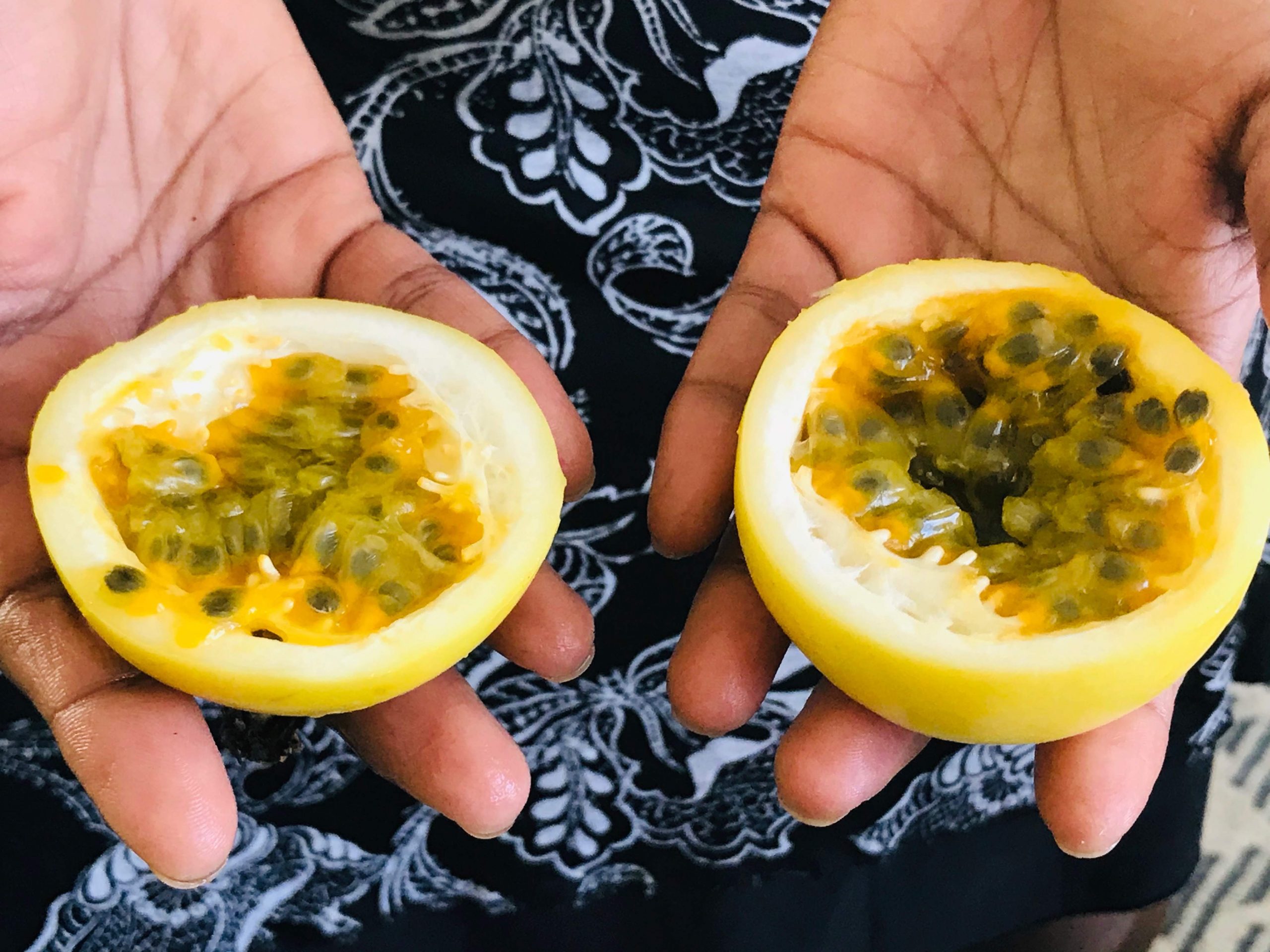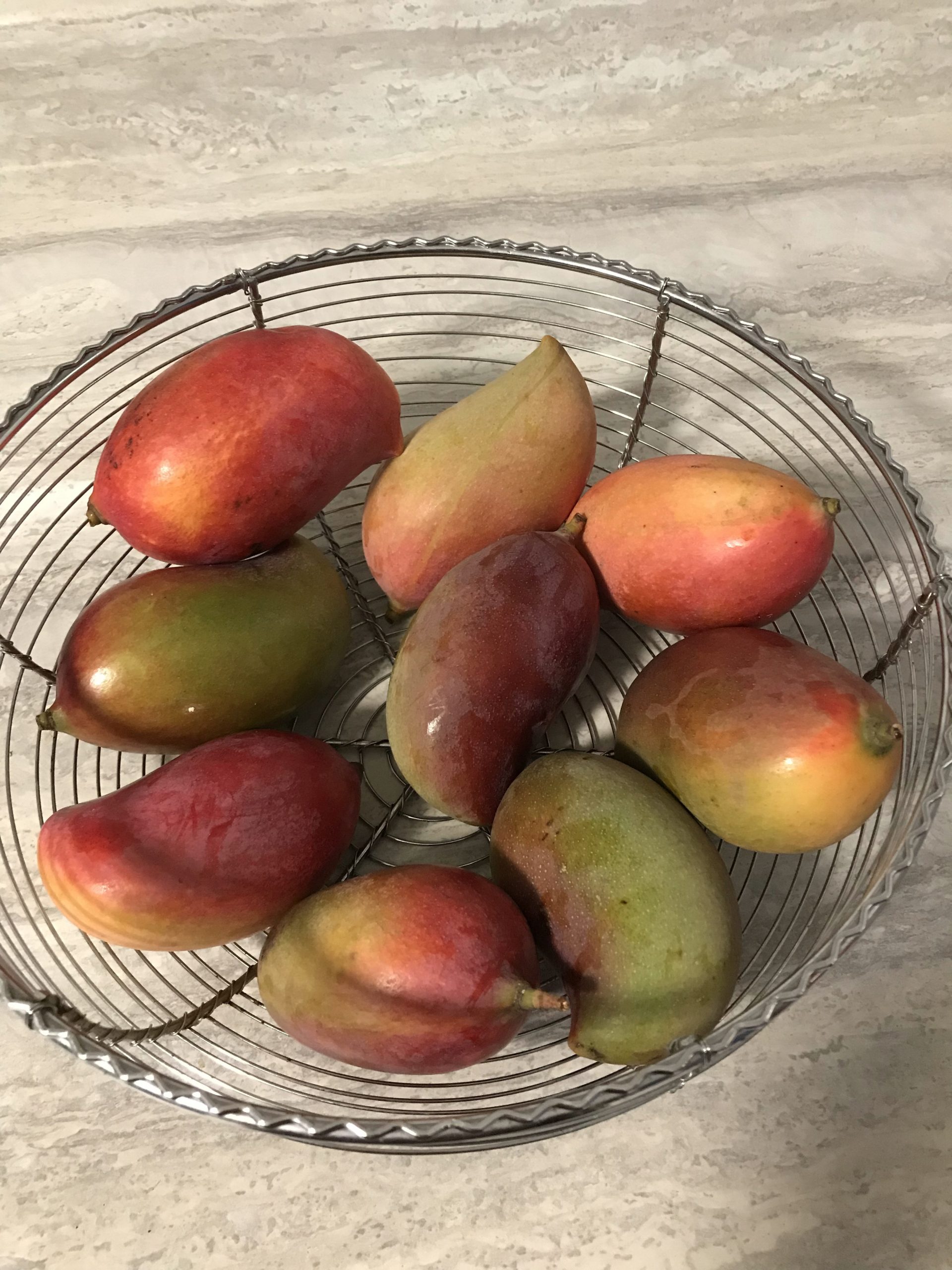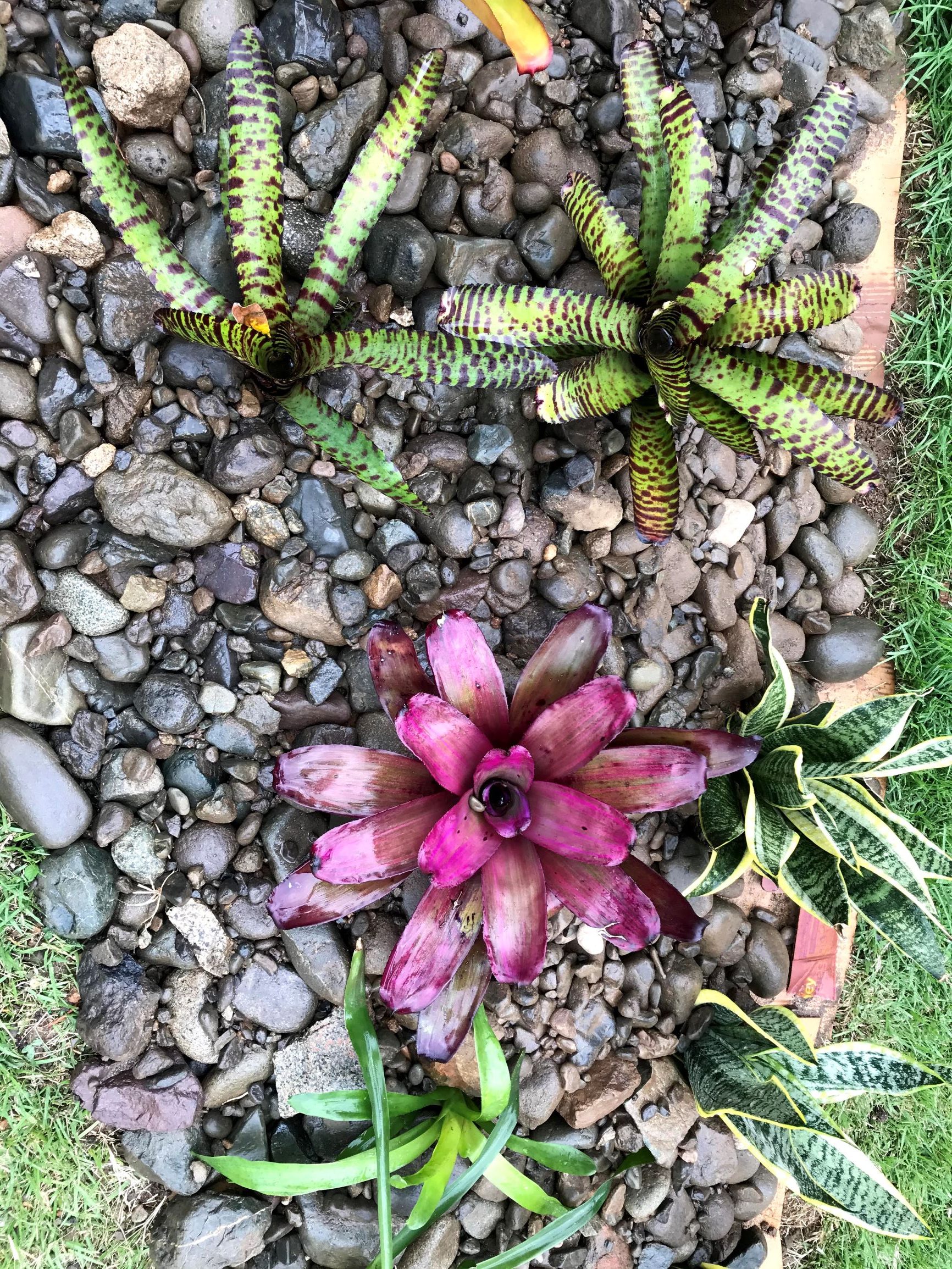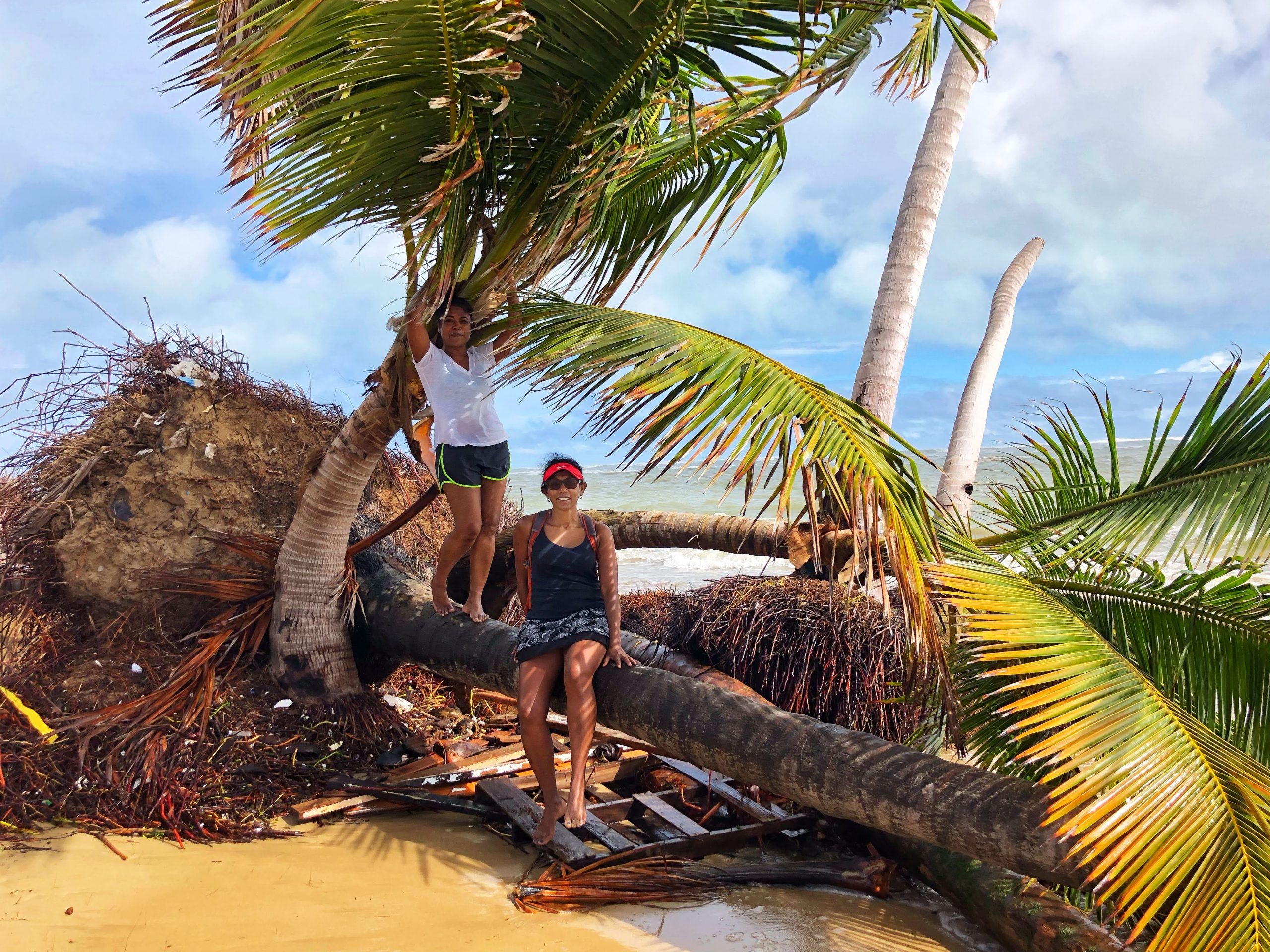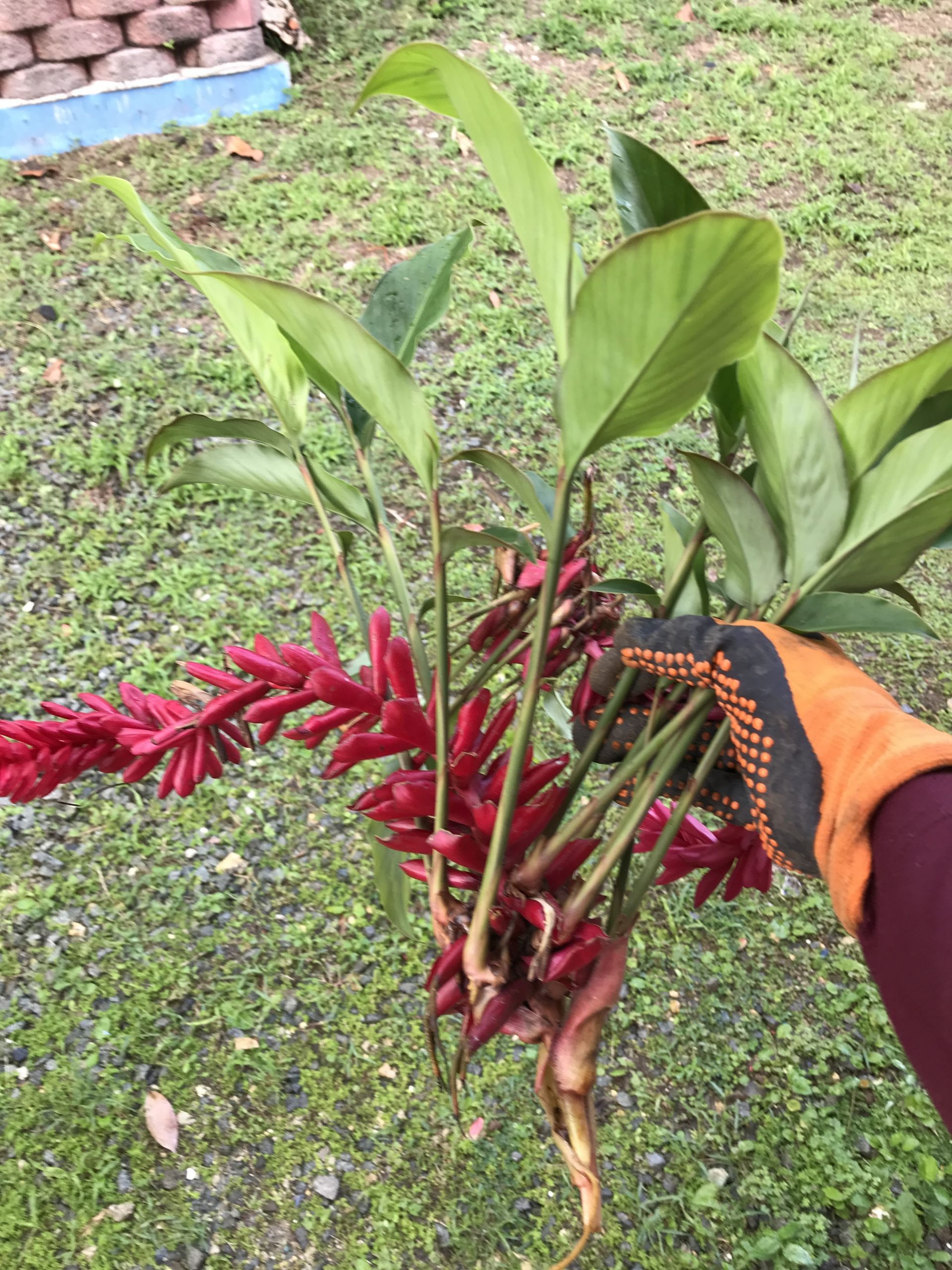read more posts by
Irene
This was another Covid year project, it took several weeks to complete. I leveled the side yard and edged it with large rocks. That was the most challenging task as moved all the rocks on the property to this area. Some of them were on the top of the hill. Some had to be dug out.
This area is visible from my kitchen window. I am slowly adding colorful foliage to the area. I also hope to create some shade in this area both for plants and to make a nice seating area.
We like to say it was the pomarosa that captured our hearts and sold the house. When my daughter Supriya and I first saw the tree, it was overgrown and weighted down with fruit. Funky looking, rose colored bunches of fruit. We did not know what they were, but they symbolized exactly what we were looking for – a tropical garden lush with exotic fruit and flowers. When, we facetimed my husband, he recognized it instantly as a Rose Apple tree.
After we bought the house, the tree received a severe trimming. So much so, I think it went into shock and did not flower for the good part of a year. But we had to do it. Ants were all over the tree and fruit. And from the tree they hopped right into our house. In addition, we need to keep each tree small, so we can fill our quarter acre with many more trees.

According to our neighbor Isaac, the bank who foreclosed on the house tried to kill the tree. In order to limit the maintenance on the garden (required by the homeowners’ association), they sprayed the yard with vegetation killer. (That explains why the grass was brown in the sales listing.) Isaac, who loves the pomarosa tree, would come over and spray water on the trunk to remove as much of the poison as possible.
When I cleared the vegetation under the tree, I found a pile of tiles and bags of cement. Indeed, the previous owner had lost interest in this home and left some projects incomplete. As I cleared the debris, I found a young adult novel, with a condom package inside. I wonder who, when and why? I am on the lookout for buried Spanish treasure, but so far I have only found this package and empty prescription bottles for weed in this garden.
The pomorosa tree fruits a good part of the year in Puerto Rico. It has white flowers that the bees love. And ants love the fruit. They hide in a pocket in the fruit, so take care when preparing the fruit.
The fruit has a mild taste, lightly sweet with a rose flavor. It is crisp and juicy yet has a lot of fiber. We mostly juice the fruit or eat it straight. It is also good in a salad.
My neighbor Juan Carlos has a white pomarosa tree. It has large fruit and tastes quite different. I have planted a seed, maybe one day we will have a white pomarosa as well.
On our first visit Puerto Rico, we enjoyed freshly squeezed Passion fruit juice. It was my first exposure, but my husband’s family grew these vines when they lived on the slopes on the Kilimanjaro in Tanzania. We decided we would grow it on the fence in the backyard. I bought a few varieties, mostly from the local stores so they did not come with tags.
Passion fruit is call Parcha in Puerto Rico. It is also known as Maracuya or Granadilla. The name, Passion Fruit, was apparently was given missionaries in Brazil as flor das cinco chagas or “flower of the five wounds” of Jesus’ crucifixion and other religious symbolism.
Within a year these vines took off! The flowers are amazingly beautiful and seem to last only one day. The fruit take several months to mature and are ready when they are crinkly. We seem to have 2 varieties – yellow and orange. Sometimes they are sweet enough to eat directly but most times a sweetener is needed.
Parcha mohitos are the bomb!
My mom and I have tried to grow the curry leaf plant several times in PA. I gave up first. These plants grow well outside in the summer but when they come inside for the winter they invariably get infected with spider mites. And they never seem to thrive enough that I can freely use their fragrant leaves for cooking.
After we bought the house in Puerto Rico, our friend Pam, an avid gardener in California offered to send me a small plant. Pam has a lot of exotic plants in her garden and we thoroughly enjoyed our tour (and tasting) when we visited in July 2016. She has now turned her garden into a plant nursery business.
Pam generously shipped me four small plants. I took two of them to Puerto Ricco. Two in case one does not survive. I planted them September 2019.

Both these plants grew vigorously. In 15 months, they are both taller than me! Whenever I plan to cook Indian food, I head to the garden and grab a few springs to add to the dishes. Just nudging the trees, releases the wonderful curry leaf aroma. I learned Padma Lakshmi’s the trick of adding curry leaves twice, once in the beginning so its flavor can be cooked into the dish and again later, to retain some of the fresher notes.
By the way, in Puerto Rico, they use these plastic rings to prevent rats from gnawing at the stems of tender plants. I have found they are more useful to protect from enthusiastic men with weed whackers.

I need more ways to use these leaves – Curry Leaf Gin and Tonic and Curry Leaf Chutney are two recipes I want to try. I am able to bring wads of these sprigs back to PA with me where I store them safely in my freezer.
According to Pam, it took seven years for her plant to grow as large as mine. My husband has given Pam (and others) facetime tours of our growing garden. She is planning a trip with her family as soon as it is safe to do so to visit her offspring.
Mangoes are my favorite fruit. I am glad they are becoming more mainstream and more varieties are available. I get a box a week from our local Indian store during the summer months. Somehow the boxes that appear in winter months in Costco and the supermarkets never ripen into juicy, finger licking goodness.
Mangoes originated in South East Asia (maybe that is why I love them) and were brought to the Caribbean by the Spanish. In Puerto Rico, there are native mango trees growing everywhere. These trees are large and gnarled. Apparently, the locals look down on these native varieties as they can be stringy.
Puerto Rico has been exporting mangos since the early 90’s and almost all of them go to Europe. The US mainland gets its mangos from Mexico, which is cheaper due to land transportation. In addition, the Keitt mango (80% of commercially grown mangoes) is preferred by the European market. Keitt is pronounced like Katy.

Of course, I had to plant a mango tree in our yard. In January 2019, found a Valencia Pride in Home Depot and planted it by the back fence. It was going to form a beautiful canopy over the back yard. Our neighbor was concerned the roots would destroy his retaining wall, so I moved the tree. It is looks healthy and happy.
Once the jungle next to the house was cleared, we discovered a large mango tree! So exciting. The fruit are small, long and sweet. The tree is on the hill, and every morning I would find that one of two mangoes had rolled down the hill for me.
This tree produces a lot of fruit. It is a bit odd that it does not follow the traditional mango season of May-Sept. But I am not complaining. We eat the fruit, juice them, make mango ice cream and popsicles. All delicious options.
I have also made mango pickle and dehydrated slices to take home as fresh mangos cannot be brought back.
My husband said we need to give our home some curb appeal. I was not sure how I could accomplish that. I did not want to create a garden that will look great but quickly become unmanageable because there is no one to maintain it on a regular basis.
Mulling the challenge over, I decided that bromeliads were the answer. These hardy plants are attractive and low maintenance. They collect water in their center. In fact these become mini-ecosystems.
I first dug a bean shaped bed around the mangosteen tree in the front yard. There was a century plant that needed to be moved. It was prickly, so I had to do that carefully. Plus there were still some fire ants under the plant from the farm I had to handle.
I bought the plants from the local nursery and arranged them based on color and size. I did later have to move a couple because the spot was too sunny for them. I used cardboard as a weed block – not sure how long this is going to be effective. Finally I laid down stones as “mulch.” I can’t wait to see how these plants mature.
When I am asked “Where is your home in Puerto Rico?,” I say it is between the San Juan Airport and El Yunque, set in the island by about 20 minutes.
After we bought the home, we tried to figure out what the absolute closest beach access was. We are on the border between Cannovanas and Rio Grande. (Actually our home is in Cannovanas but the Post Office is in Rio grande which results in lost and returned mail.)
Luquillo Beach is the most popular nearby beach. It is about 30 minutes away and very popular with both the tourists and locals. It is a beautiful crescent with soft sand, palm trees and turquoise water. However it is very busy with restaurants, people, cars and music.
The closest beach is quiet and serene. Initially there was no commercial activity but the last time we went the abandoned restaurant was operational over the weekend. Disappointing but turns out their Mojitos are pretty good.
I call this spot Bahia Beach since it is near the beautiful St. Regis Bahia Beach Resort. From our home, head towards Luquillo Beach, then turn towards the ocean on Route 187. Once you pass the resort, you go over a bridge. Make the next right, which will swing you back to a parking area. The Rio Herrera meets the ocean at this spot.
The area/town is Vieques on the eastern most tip of Loiza. I don’t call it Vieques because it would be confused with the island.

If you walk along the beach towards Loiza, you will see abandoned shacks. Sometimes I see families picnicking in these areas. We find a nice palm tree and rock and spend a few hours enjoying an empty beach.
One evening I was sitting on this beach with my friend Heather, enjoying some happy hour cocktails and cheese. All of a sudden a man with a machete walks by. We were a bit startled but he was just going after a coconut. Another time, a wild horse ran onto the beach. He saw me and bolted. I love these surprises!
We visit Puerto Rico every couple of months. And the beaches are never remain the same. Sometimes there are uprooted palm trees, a treasure trove of shells, a lot of seaweed on the beach or in the water and even a lot of trash. Things constantly change around here and we go with the flow.
Coordinates: 18.423254, -65.829680
Being a frugal gardener, I’m always on the lookout for plants that can be easily propagated. Why pay top dollar for a plant when one can be easily started with a seed or cutting? On my very first trip, I noticed that the tropical plants we buy and keep indoors grow all over the place in Puerto Rico. Of course, there are weeds and plants that are not appreciated but if you look closely you will see desirable plants. I always have shears and plastics bags with me in the car for such opportunities.
In many cases, if you see a home with nice plants, these plants will self propagate and grow outside their property. What is the harm in a little plant foraging? As you can see from these pictures, Supriya and I have brought home some nice varieties. Unfortunately, since we do not stay in Puerto Rico for more than a few weeks, these newcomers may not receive all the care that they need. I say a prayer in my garden before we leave, leaving my plants in God’s care. And many do survive.
In Puerto Rico, our windows are open all the time. If it is extremely warm, we close the bedroom windows and turn on the AC. But most nights, the windows are open, and we can hear the sounds of the night. These sounds include cats fighting, dogs barking, rooster’s crowing and last but not least coqui’s chirping.
The coqui (pronounced ko-kee) is a tiny frog that is native to Puerto Rico and is the national symbol of the island. These small frogs produce a loud chirp at night, up to 90 decibels. These calls are made by male frogs to attract females and fend off the competition. After the rain, male coquis are highly active and loud.
It does take a few days before you can sleep though this cacophony. My son claims he has PTSD from the experience.
My husband is not a fan either. A few coqui decided to seek refuge (or play hanky panky) in one of the new AC units. And they managed to fry some of the circuitry. The unit was still under warranty, but we had to pay for the service call.

To me, they are an intrinsic part of the island. Sometimes, from PA, when I check on the house via the webcams, I turn up the volume and listen to the unmistakable sound of the coquis calling me back home.






